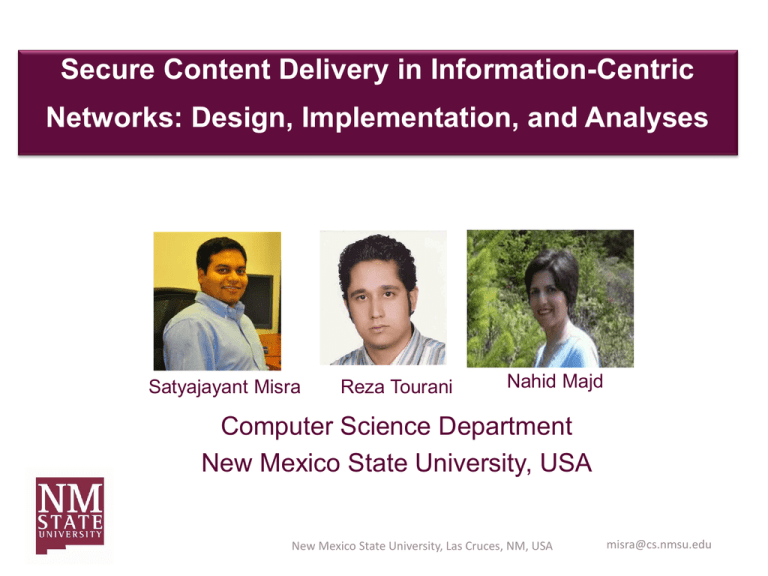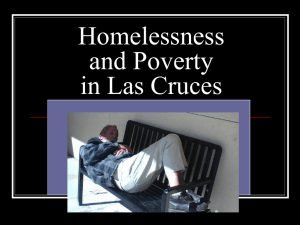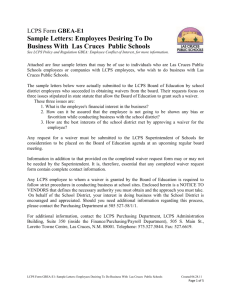Slides
advertisement

Secure Content Delivery in Information-Centric Networks: Design, Implementation, and Analyses Satyajayant Misra Reza Tourani Nahid Majd Computer Science Department New Mexico State University, USA New Mexico State University, Las Cruces, NM, USA misra@cs.nmsu.edu Agenda • • • • • Introduction and Motivation Models and Assumptions Design of Framework Testbed Results Conclusion New Mexico State University, Las Cruces, NM, USA The Cisco Visual Networking Index underlines the need for a high bandwidth content-centric Internet. • High bandwidth video makes 51% of the Internet traffic today and would rise to 54% by 2016; • Sum of all video traffic would become approximately 86% of global traffic; • By 2014, mobile wireless devices will account for 61% of world Internet traffic. New Mexico State University, Las Cruces, NM, USA What does this traffic trend mean for the future of the Internet? Bandwidth Intensive Unsustainable New Mexico State University, Las Cruces, NM, USA A typical content delivery hierarchy in today’s Internet. Content Provider CDN Nodes ISP Nodes New Mexico State University, Las Cruces, NM, USA End Users However, using CDNs does not solve the bandwidth bottleneck problem at the ISPs (the edge). Redundant/Duplicate transmissions Solution: In-network caching atundermine the ISP-level. network performance New Mexico State University, Las Cruces, NM, USA In-network caching at the ISPs will help reduce bandwidth requirement at the ISP level. New Mexico State University, Las Cruces, NM, USA The important concern is, how do we ensure high availability of the cached data only to legitimate users? New Mexico State University, Las Cruces, NM, USA Let’s look at a simplified example of how your content is delivered to your Netflix player from the Netflix server. Amazon EC2 Microsoft’s Individualization Server Netflix’s Regular Webserver Your Player Netflix Control Server Netflix License Server Netflix Streaming Server (Akamai, etc.) New Mexico State University, Las Cruces, NM, USA If the Cloud is down, then the service is down! New Mexico State University, Las Cruces, NM, USA These conditions serve as the motivation for this work. For more than 20 million users; revocation of 1-2 million users; system reinitialization possible. New Mexico State University, Las Cruces, NM, USA We use a Shamir’s secret-sharing based broadcast encryption mechanism* for content security. n: total number of users; t: maximum revocation threshold Server sends t shares, user adds one more to make t+1. * W. Tzeng and Z. Tzeng. A public-key traitor tracing scheme with revocation using dynamic shares. In Public Key Cryptography, pages 207–224, 2001. New Mexico State University, Las Cruces, NM, USA The basic steps are split between the server and the client, with the operations being heavy on the server-side. Server encrypts content using a symmetric key It generates “n + t” shares Gives each user one of the shares Encrypts the key using “t” shares and makes it available Legitimate user adds his share to create t+1 shares to decrypt the key * W. Tzeng and Z. Tzeng. A public-key traitor tracing scheme with revocation using dynamic shares. In Public Key Cryptography, pages 207–224, 2001. New Mexico State University, Las Cruces, NM, USA The framework has three basic protocols: First two performed at the server and the last one at the client. Polynomials and shares generation at the server Enabling block generation and encryption at the server Secret Extraction at the mobile user We perform pre-computations at the server so user has to perform only O(t) computations to obtain secret key. New Mexico State University, Las Cruces, NM, USA CCN/NDN Architecture Details: User Registration, Chunk Creation, Packet Naming, Versioning, User Revocation Sequence Numbers: Sequential or Random Versioning: Content and Enabling Block can have different numbers, versions can help with expiration. User Registration and Revocation: Messages transmitted as interests. New Mexico State University, Las Cruces, NM, USA We have addressed some of the questions pertaining to the handling of system dynamics in the framework. • How to revoke a subscribed user at the end of the subscription? • Can we handle the case where the number of revoked user is more than t the system revocation threshold? • How do we handle new user(s) when the system reaches user capacity? New Mexico State University, Las Cruces, NM, USA The framework was implemented in a CCNx testbed to verify its feasibility for mobile users. • • • • • CCNx-0.7 codebase. 3 nodes: Intel Core i7, 8 GB RAM, 2.4 GHz. Code in C++, compiled with gcc 4.5.2. GNU multi-precision arithmetic library. 24.1 MB video hosted using the ccnputfile command. • n: 1 M to 20 M in increments of 5 M. • t: 5 K to 40 K in increments of 5 K. • Experiments were run over 100 runs. New Mexico State University, Las Cruces, NM, USA We implemented two versions: No Server-side Precomputation (SD) & Server-side Pre-computation (PSD). • No server-side pre-computation => No computation of the Lagrangian interpolation at the server, requiring O(t2) computations at the mobile device. • Server-side pre-computation => The Lagrangian interpolation variables are partially computed at the server; only O(t) computations at the mobile device. New Mexico State University, Las Cruces, NM, USA Polynomial generation and user shares generation depended on the number of users in the system. Cost increases for large number of users, however, this part can be parallelized easily. New Mexico State University, Las Cruces, NM, USA The pre-computation at the server adds to the enabling block cost, however the overhead is still modest. Even in PSD, the addition of the enabling block to the content transmission adds only a 0.3% overhead for a 300 MB movie. New Mexico State University, Las Cruces, NM, USA The extraction at the user with PSD is far better than in SD, hence is recommended. Even when t is 1 million it takes 4.17 seconds (0.06% of a standard Netflix movie time) to extract using one 2.4 GHz processor. New Mexico State University, Las Cruces, NM, USA Conclusions: Our framework will scale to large number of mobile users • Legitimate users can access content available close-by. • Even when the CP is down! • The framework is tailor-made for mobile users. • It is efficient to scale to several million users • Tested for upto 20 million subscribers. • Number of revoked users upto 1 million. • CCNx testbed implementation results show promise. New Mexico State University, Las Cruces, NM, USA Thank You New Mexico State University, Las Cruces, NM, USA misra@cs.nmsu.edu New Mexico State University, Las Cruces, NM, USA







